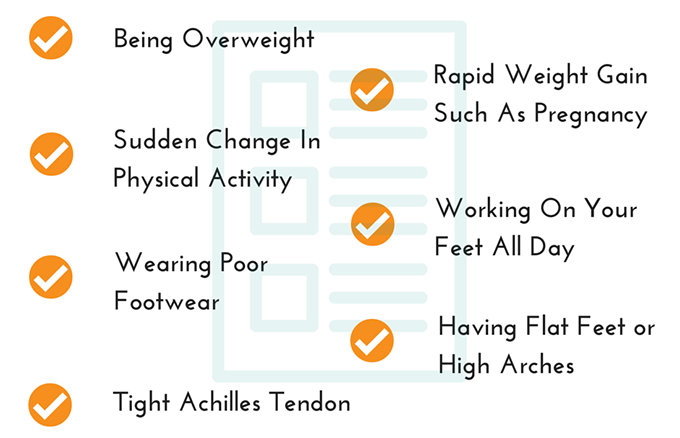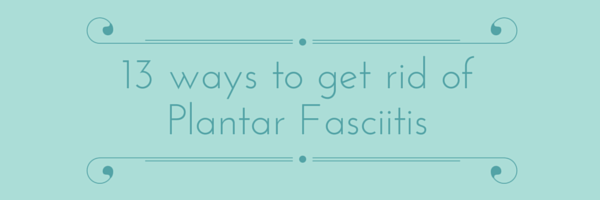If you are wondering how to get rid of plantar fasciitis, most experts agree that you’ll need to undergo a temporary lifestyle change. By modifying a few of your routines – as quickly as possible – you may be more likely to cure your plantar fasciitis than if you’d otherwise continue with your current way of life. It’s no walk in the park, but if you are dedicated to a quicker recovery, you should plan for a change.
For a brief overview of the condition, see our infographic on What Is Plantar Fasciitis.
How Do You Get Plantar Fasciitis
There’s no one way that you can get plantar fasciitis as it can be acquired any number of ways depending on you and your lifestyle. By visiting a Podiatrist, you’ll be able to get a better understanding of your situation through an initial consultation. You’ll likely discuss your medical history, activity levels and several other factors that may help to draw a conclusion to your situation. Here are a few things that may contribute to your heel pain issues.

Besides being overweight, there are several other risk factors that seem to contribute to getting plantar fasciitis. People who gain weight quickly – such as pregnant women – may have a higher chance of getting it, as well as those that suddenly change their activity levels from stagnant to active (or vice versa).
Jobs that require you to stand on your feet all day, such as Police Officers, Nurses, Warehouse employees, etc. may also be prone to having heel pain.
Exacerbating the situation may include wearing out-dated footwear with the typical ‘worn heels’ markings on the back of the shoe and/or not having sufficient arch support inside.
But of course, how you get it is probably less important to you than how to get rid of plantar fasciitis.
How To Relieve Plantar Fasciitis
Although in most cases you can live your life dealing with plantar fasciitis, you’ll no doubt be sacrificing a higher standard of living. Nobody wants to simply live their lives, though. Here are several ways that will be suggested by your Podiatrist or Physical Therapist to relieve that often-excruciating pain either temporarily or, in many cases, for good.
1. Get Some Rest
One of the best ways to “get back on your feet again” will be to simply rest your feet. Take a break from any physically demanding activities that you’ve perhaps been participating in such as running, intense training, etc.
2. Ice Your Feet
In a recent study of 99 individuals conducted to evaluate the efficacy of heat, cold and NSAIDs on plantar fasciitis – independent of other treatment protocols – results showed that the group with the greatest relief from symptoms was from the one that applied a cold treatment routine 20 minutes before bedtime. Tests revealed reduced thickness of the plantar fascia and reduced pain levels. What’s more, the icing protocol combined with ibuprofen showed even better results.
3. Stretching
Doing certain foot and plantar fascia stretches can be beneficial to relieving some of the pains associated with plantar fasciitis. See some of the quick and simple stretching videos below for a few routines you can try at home.
4. Massage
By simply applying pressure and gently massaging your arches you will be loosening the fascia ligament as well as the other muscles along the bottom of the foot. This can be effective for some immediate gratification, though it may also provide initial discomfort.
You may also be interested in the Graston Technique, which uses specialized tools to firmly massage a few of the muscles that are thought to contribute to plantar fasciitis, such as the calf and Achilles tendon. In fact, a recent study on the effects of soft tissue mobilization in conjunction with a static stretching routine proved significantly more efficacious than stretching alone in reducing pain and improving ankle dorsiflexion.
5. Taping Your Feet
A growing trend you may have noticed has been that of athletes to use kinesiology tape to stretch their muscles while still maintaining full range of motion. Its benefit lies in the ability to stretch, provide support and relieve pain. This treatment option is used for many common injuries, including by physical therapists who do taping for plantar fasciitis.
6. Orthotic Inserts
Studies have shown that one of the best things you can do to get rid of plantar fasciitis is to have a routine that includes the use of orthotic inserts for your shoes. There are several different types available, including for those with wide feet, high arches, ones specifically for runners and more.
7. Night Splint
Much like adding a custom or pre-fabricated orthotic insert, night splints have shown to be successful in the treatment of heel pain and in particular limiting the stabbing morning pains associated with the condition.
8. Cortisone Injections
A popular method used to eradicate some of the pains you may be suffering from is to get cortisone injections in your heel. This will be performed by your doctor and results are typically immediate and lasting for a few weeks. Results may vary.
9. NSAIDs (Non-Steroidal Anti-Inflammatory)
Many people opt for non-invasive treatments and NSAIDs provide that for them. By using Tylenol and other anti-inflammatory medications, you might expect to see some benefit as well. Talk to your doctor before using any medication.
10. Physical Therapy
This is another option for those that may not respond to at-home, non-invasive treatments and you may wish to consider physical therapy to help cut down on the pain. Results may vary, so contact your doctor to find out if it is right for you.
11. Acupuncture
Although not one of the more popular methods that are used in eradicating plantar fasciitis, many people will lean towards acupuncture and other natural treatments for plantar fasciitis looking for additional support.
12. Platelet Rich Plasma Injections
One of the not-so-known treatment options for your heel pain is to undergo platelet rich plasma injections. The basic idea is to remove a sample of your blood, spin it in a centrifuge, collect the collagen and then re-inject it into your foot to stimulate healing of the fascia.
13. Surgery
As a last resort, a small percentage of patients will opt for surgery to try and fix a nagging condition. Normally only suitable for those with chronic, debilitating plantar fasciitis, surgery still may not guarantee a fix. This is something your physician will help determine if it is right for you.
Plantar Fasciitis Products
There are several products on the market that are geared to help heel pain sufferers. Some are designed by actual practitioners based on patient histories and using knowledge of what works for them. See our reviews (in the menu bar) of products to learn more about each one including statistics and which ones people like best.

Night Splints are one of the few treatment options that are statistically proven to minimize treatment time and pain. A few people may find them uncomfortable to sleep with, but also comment on the benefits seen when waking up in the morning.
Orthotic Inserts are another product that has been backed by studies and have shown to have a positive impact on recovery time.
Good shoes for walking (or for working) are suggested as well since they can help correct your walking gait, which contributes to plantar fasciitis. And if you’re going to be on your feet all day, you should look into having better support to help resolve your condition quicker. Certain shoes have the benefit of already including sufficient arch support, so you may not need additional orthotics.
While there are many other products you can try that have worked for others, these 3 might be the most effective as per studies that have been performed to validate their status as a treatment option for plantar fasciitis.
Plantar Fasciitis Exercises (Youtube Videos)
There are a few exercises that are recommended to stretch your fascia, as well other lower extremity stretches that may be soothing and/or effective in providing pain relief. Here are a few easy participation videos that you can do from the comfort of your home with just a few minutes of your time.
Wall Foot Stretching Exercises
Rolling A Ball Under Your Foot
Conclusion
You should now know how to get rid of plantar fasciitis via at-home techniques as well as some advanced treatment options. These are many of the documented options that have worked for others that are going through exactly what you are going through. In any event, you should always speak with your physician before beginning a treatment protocol.
We all know that no two people are the same and what brought on your plantar fasciitis may not be the same as everyone else. That, of course, is part of the process you’ll have to figure out by trial and error. See your physician for explicit advice on how you can deal with your specific situation.
If you found value in this post, please like and share (on the left) for others to benefit as well!

